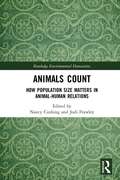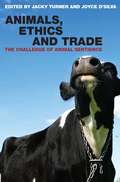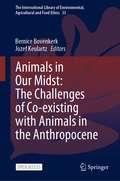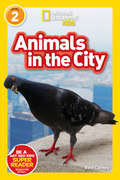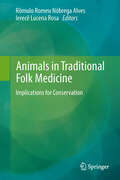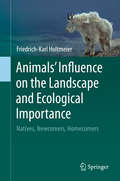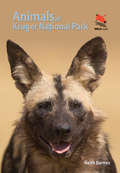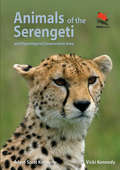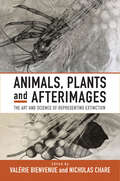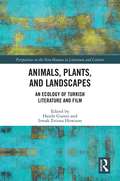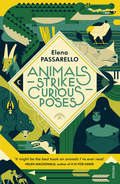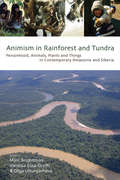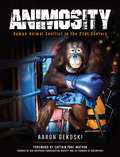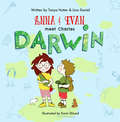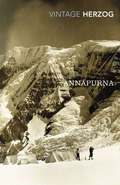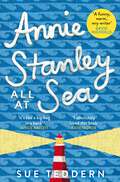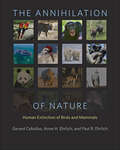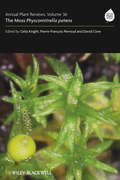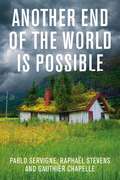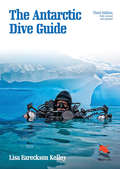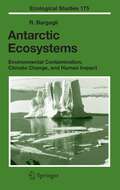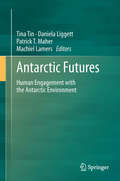- Table View
- List View
Animals Count: How Population Size Matters in Animal-Human Relations (Routledge Environmental Humanities)
by Nancy Cushing Jodi FrawleyWhether their populations are perceived as too large, just right, too small or non-existent, animal numbers matter to the humans with whom they share environments. Animals in the right numbers are accepted and even welcomed, but when they are seen to deviate from the human-declared set point, they become either enemies upon whom to declare war or victims to be protected. In this edited volume, leading and emerging scholars investigate for the first time the ways in which the size of an animal population impacts how they are viewed by humans and, conversely, how human perceptions of populations impact animals. This collection explores the fortunes of amphibians, mammals, insects and fish whose numbers have created concern in settler Australia and examines shifts in these populations between excess, abundance, equilibrium, scarcity and extinction. The book points to the importance of caution in future campaigns to manipulate animal populations, and demonstrates how approaches from the humanities can be deployed to bring fresh perspectives to understandings of how to live alongside other animals.
Animals, Ethics and Trade: The Challenge of Animal Sentience
by Joyce D'Silva Jacky TurnerModern urban life cuts us off from direct connection with the animal world, yet daily the lives of millions of animals are affected by what we consume and wear and what we trade in. The use of animals for food, labour and pleasure pursuits has long been justified with the assumption that unlike humans, animals aren't fully sentient beings. In recent years, however, science has revealed an astonishing array of complex animal behaviour, and scientists and policy makers now accept that the animals we make use of are indeed conscious, with preferences and intentions. The implications for our culture of factory farming, fast food and rainforest liquidation are staggering. In this powerful book, internationally renowned experts on animal behaviour and agriculture such as Jane Goodall, Tim Lang and Vandana Shiva are brought together with ethicists, religious scholars, international industry and regulators for the first time to debate these critical issues and tackle the profound implications of animal sentience. ? The first sections discuss scientific and ethical perspectives on the consciousness, emotions and mental abilities of animals. Later sections address how human activities such as science, law, religion, farming, food production, trade, development and education respect or ignore animals' sentience and welfare, and review the options for changes in our policies, our practices and our thinking. The result is nothing less than a stark and necessary look into the heart of humanity and the ethics that govern our animal powered society.
Animals, Ethics and Trade: The Challenge of Animal Sentience
by Joyce D'Silva Jacky TurnerModern urban life cuts us off from direct connection with the animal world, yet daily the lives of millions of animals are affected by what we consume and wear and what we trade in. The use of animals for food, labour and pleasure pursuits has long been justified with the assumption that unlike humans, animals aren't fully sentient beings. In recent years, however, science has revealed an astonishing array of complex animal behaviour, and scientists and policy makers now accept that the animals we make use of are indeed conscious, with preferences and intentions. The implications for our culture of factory farming, fast food and rainforest liquidation are staggering. In this powerful book, internationally renowned experts on animal behaviour and agriculture such as Jane Goodall, Tim Lang and Vandana Shiva are brought together with ethicists, religious scholars, international industry and regulators for the first time to debate these critical issues and tackle the profound implications of animal sentience. ? The first sections discuss scientific and ethical perspectives on the consciousness, emotions and mental abilities of animals. Later sections address how human activities such as science, law, religion, farming, food production, trade, development and education respect or ignore animals' sentience and welfare, and review the options for changes in our policies, our practices and our thinking. The result is nothing less than a stark and necessary look into the heart of humanity and the ethics that govern our animal powered society.
Animals in Our Midst: The Challenges of Co-existing with Animals in the Anthropocene (The International Library of Environmental, Agricultural and Food Ethics #33)
by Bernice Bovenkerk Jozef KeulartzThis Open Access book brings together authoritative voices in animal and environmental ethics, who address the many different facets of changing human-animal relationships in the Anthropocene. As we are living in complex times, the issue of how to establish meaningful relationships with other animals under Anthropocene conditions needs to be approached from a multitude of angles. This book offers the reader insight into the different discussions that exist around the topics of how we should understand animal agency, how we could take animal agency seriously in farms, urban areas and the wild, and what technologies are appropriate and morally desirable to use regarding animals. This book is of interest to both animal studies scholars and environmental ethics scholars, as well as to practitioners working with animals, such as wildlife managers, zookeepers, and conservation biologists.
Animals in the City (National Geographic Readers)
by National Geographic KidsFrom pigeon pizza parties in New York City to koala street crossings in Australia, wild animals all over the world show us how they live in cities, interact with humans, and strut their street smarts in this new reader from National Geographic Kids.
Animals in Traditional Folk Medicine: Implications for Conservation
by Rômulo Romeu Nóbrega Alves and Ierecê Lucena RosaPeople have relied on medicinal products derived from natural sources for millennia, and animals have long been an important part of that repertoire; nearly all cultures, from ancient times to the present, have used animals as a source of medicine. Ingredients derived from wild animals are not only widely used in traditional remedies, but are also increasingly valued as raw materials in the preparation of modern medicines. Regrettably, the unsustainable use of plants and animals in traditional medicine is recognized as a threat to wildlife conservation, as a result of which discussions concerning the links between traditional medicine and biodiversity are becoming increasingly imperative, particularly in view of the fact that folk medicine is the primary source of health care for 80% of the world’s population. This book discusses the role of animals in traditional folk medicine and its meaning for wildlife conservation. We hope to further stimulate further discussions about the use of biodiversity and its implications for wildlife conservation strategies.
Animals' Influence on the Landscape and Ecological Importance: Natives, Newcomers, Homecomers
by Friedrich-Karl HoltmeierIn its first English-language edition, this book introduces the many-faceted interactions of animal populations with their habitats. From soil fauna, ants and termites to small and large herbivores, burrowing mammals and birds, the author presents a comprehensive analysis of animals and ecosystems that is as broad and varied as all nature. Chapter 2 addresses the functional role of animals in landscape ecosystems, emphasizing fluxes of energy and matter within and between ecosystems, and the effects of animals on qualitative and structural habitat change. Discussion includes chapters on the role of animal population density and the impacts of native herbivores on vegetation and habitats from the tropics to the polar regions. Cyclic mass outbreaks of species such as the larch bud moth in Switzerland, the mountain pine beetle and the African red-billed weaver bird are described and analyzed. Other chapters discuss Zoochory – the dispersal of seeds by ants, mammals and birds – and the influence of burrowing animals on soil development and geomorphology. Consideration extends to the impact of feral domestic animals. Chapter 5 focuses on problems resulting from introduction of alien animals and from re-introduction of animal species to their original habitats, discusses the effects on ecosystems of burrowing, digging and trampling by animals. The author also addresses keystone species such as kangaroo rats, termites and beavers. Chapter 6 addresses the role of animals in landscape management and nature conservation, with chapters on the impact of newcomer species such as animals introduced into Australia, New Zealand and Europe, and the consequences of reintroduction of species to original habitat. It also discusses the carrying capacity of natural habit, public attitudes toward conversation and more. The final section ponders the effects of climate on interactions between animals and their habitats.
Animals of Kruger National Park (PDF)
by Keith BarnesSouth Africa's Kruger National Park is one of the largest and most diverse conservation areas in Africa, and a hugely popular visitor attraction. Animals of Kruger National Park is a compact and beautifully illustrated guide, and the essential companion for any safari to the region. With an eye-catching design, authoritative and accessible text and easy-to-use format, this detailed photographic guide provides information on identification, habitat, behaviour, biology and conservation for all the mammals, reptiles and frogs likely to be seen. Introductory sections provide background information on the park and its habitats, when to visit and where to go, and other practical considerations that will help to enhance your understanding, appreciation and enjoyment of the animals of this incredible region. The essential all-in-one Kruger safari companion, ideal for all visitors Unique and attractive layout, featuring 216 stunning colour photographs, 116 track (spoor) illustrations and two maps Covers 57 mammals, 17 reptiles and eight frogs Features the ‘Big 5’—elephants, leopards, lions, rhinoceroses and buffalos—as well as other iconic and charismatic animals Provides key information on identification, behaviour, biology and conservation
Animals of the Serengeti: And Ngorongoro Conservation Area (PDF)
by Adam Scott Kennedy Vicki KennedyContaining 146 stunning color photos, Animals of the Serengeti is a remarkable look at the mammals and reptiles most likely to be encountered in the world-famous Serengeti National Park and Ngorongoro Crater. With an eye-catching layout, accessible text, and easy-to-use format, this detailed photographic guide includes 89 species of mammal and reptile. Useful "Top Tips"—shared by local Tanzanian guides that work in the region—provide visitors with insights into behavioral habits and how to locate specific animals. Filled with vivid anecdotes, Animals of the Serengeti will enable any safari traveler to identify the area's wildlife with ease.Covers the 89 species likely to be encountered in Tanzania’s Serengeti National Park and Ngorongoro Conservation Area Features male and female variationsAccessible text aimed at safari visitors of all levels
Animals, Plants and Afterimages: The Art and Science of Representing Extinction
by Valérie Bienvenue Nicholas ChareThe sixth mass extinction or Anthropocene extinction is one of the most pervasive issues of our time. Animals, Plants and Afterimages brings together leading scholars in the humanities and life sciences to explore how extinct species are represented in art and visual culture, with a special emphasis on museums. Engaging with celebrated cases of vanished species such as the quagga and the thylacine as well as less well-known examples of animals and plants, these essays explore how representations of recent and ancient extinctions help advance scientific understanding and speak to contemporary ecological and environmental concerns.
Animals, Plants and Afterimages: The Art and Science of Representing Extinction
by Nicholas Chare Valérie BienvenueThe sixth mass extinction or Anthropocene extinction is one of the most pervasive issues of our time. Animals, Plants and Afterimages brings together leading scholars in the humanities and life sciences to explore how extinct species are represented in art and visual culture, with a special emphasis on museums. Engaging with celebrated cases of vanished species such as the quagga and the thylacine as well as less well-known examples of animals and plants, these essays explore how representations of recent and ancient extinctions help advance scientific understanding and speak to contemporary ecological and environmental concerns.
Animals, Plants, and Landscapes: An Ecology of Turkish Literature and Film (Perspectives on the Non-Human in Literature and Culture)
by Hande Gurses Irmak Ertuna HowisonThe landscape of Turkey, with its trees and animals inspires narratives of survival, struggle and escape. Animals, Plants, and Landscapes: An Ecology of Turkish Literature and Film, will be the first major study to offer fresh theoretical insight into this landscape, by offering a collection of analyses of key texts of Turkish literature and cinema. Through discussion of both classical and contemporary works, this volume, paves the way for the formation of a ecocritical canon in Turkish literature and the rise of certain themes that are unique to Turkish experience. Snakes, fishermen and fish who catch men, porcupines contemplating on human agency, dogs exiled on an island and men who put dogs to fights, goat herders and windy steppes of Anatolia are all agents in a territory that constantly shifts. The essays included in this volume demonstrate the ways in which the crystallized relations between human and non-human form, break, and transform.
Animals, Plants, and Landscapes: An Ecology of Turkish Literature and Film (Perspectives on the Non-Human in Literature and Culture)
by Hande Gurses Irmak Ertuna HowisonThe landscape of Turkey, with its trees and animals inspires narratives of survival, struggle and escape. Animals, Plants, and Landscapes: An Ecology of Turkish Literature and Film, will be the first major study to offer fresh theoretical insight into this landscape, by offering a collection of analyses of key texts of Turkish literature and cinema. Through discussion of both classical and contemporary works, this volume, paves the way for the formation of a ecocritical canon in Turkish literature and the rise of certain themes that are unique to Turkish experience. Snakes, fishermen and fish who catch men, porcupines contemplating on human agency, dogs exiled on an island and men who put dogs to fights, goat herders and windy steppes of Anatolia are all agents in a territory that constantly shifts. The essays included in this volume demonstrate the ways in which the crystallized relations between human and non-human form, break, and transform.
Animals Strike Curious Poses
by Elena PassarelloBeginning with Yuka, a 39,000-year-old mummified woolly mammoth recently found in the Siberian permafrost, each of the sixteen essays in Animals Strike Curious Poses investigates a different famous animal named and immortalised by humans. Here are the starling that inspired Mozart with its song, Darwin’s tortoise Harriet, and in an extraordinary essay, Jumbo the elephant (and how they tried to electrocute him). Modelled loosely on a medieval bestiary, these witty , playful, provocative essays traverse history, myth, science and more, introducing a stunning new writer to British readers.
Animism in Rainforest and Tundra: Personhood, Animals, Plants and Things in Contemporary Amazonia and Siberia
by UnknownAmazonia and Siberia, classic regions of shamanism, have long challenged ‘western’ understandings of man’s place in the world. By exploring the social relations between humans and non-human entities credited with human-like personhood (not only animals and plants, but also ‘things’ such as artifacts, trade items, or mineral resources) from a comparative perspective, this volume offers valuable insights into the constitutions of humanity and personhood characteristic of the two areas. The contributors conducted their ethnographic fieldwork among peoples undergoing transformative processes of their lived environments, such as the depletion of natural resources and migration to urban centers. They describe here fundamental relational modes that are being tested in the face of change, presenting groundbreaking research on personhood and agency in shamanic societies and contributing to our global understanding of social and cultural change and continuity.
Animosity: Human-Animal Conflict in the 21st Century
by Aaron GekoskiThe world’s wildlife is in crisis.Globally, animals are being traded, hunted, poached, consumed and exploited to the point of extinction. This is their story, as told through the lens and eyes of Aaron ‘Bertie' Gekoski, an internationally acclaimed environmental photojournalist, who documents human-animal conflict in the most inhospitable places on Earth.ANIMOSITY is a collection of powerful photographs and absorbing tales from the frontline of conservation: from Cambodia’s dog-drowning dungeons and West Africa’s voodoo markets, to cruel Wildlife Tourism Attractions and the shadowy world of the exotic pet trade.Conflict, conservation, and the battle to coexist: ANIMOSITY is the story of our generation, our legacy.Numerous animal welfare NGOs have lent their backing to the book including Born Free Foundation, Four Paws, World Animal Protection, International Animal Rescue, PETA & Scubazoo, while world famous actresses Shannon Elizabeth and Amy Jackson have written moving testimonies for the book.The foreword has been written by one of the best-known environmental activists in the world, Captain Paul Watson, founder of the Sea Shepherd conservation society and a co-founder of Greenpeace.
Anna And Evan Meet: Charles Darwin (Anna And Evan Meet)
by Tanya HutterJoin Anna and Evan on a magical adventure to the Galapagos Islands where they meet Charles Darwin, discover unusual animals and learn some interesting scientific facts.This engaging and educational book is ideal for young children to encourage curiosity and interest in the natural world and science.
Annapurna: The First Conquest of an 8000-Metre Peak (Lyons Press Series)
by Maurice Herzog Joe SimpsonOne of the great works of mountaineering literatureWITH AN INTRODUCTION BY JOE SIMPSONIn 1950, no mountain higher than 8,000 meters had ever been climbed. Maurice Herzog and other members of the French Alpine Club resolved to try. This is the enthralling story of the first conquest of Annapurna and the harrowing descent. With breathtaking courage and grit manifest on every page, Annapurna is one of the greatest adventure stories ever told.As well as an introduction by Joe Simpson, this new edition includes 16 pages of photographs, which provide a remarkable visual record of this legendary expedition.The distinguished French mountaineer Maurice Herzog was leader of the 1950 expedition to Annapurna. He was one of the two climbers to reach the summit.
Annie Stanley, All At Sea
by Sue TeddernSometimes the end is only the beginning . . . Annie is single, unemployed and just a bit stuck when her beloved father dies unexpectedly. Furious at his partner’s plans to scatter his ashes somewhere of no emotional significance, Annie seizes the urn and, on a whim, decides to take it on a tour of the thirty-one sea areas that make up the shipping forecast, which her father loved listening to, despite living in landlocked St Albans. Travelling around the coastline of Britain searching for the perfect place to say goodbye, she starts to wonder if it might be time to rethink some of the relationships in her life – but is it too late for second chances?A novel about love, loss and the importance of living life to the full, Annie Stanley, All at Sea by Sue Teddern is proof that it’s often the most difficult moments in life that show us what really matters.'Witty, wise with wonderful characters. I absolutely loved this book' - Katie Fforde
The Annihilation of Nature: Human Extinction of Birds and Mammals
by Paul R. Ehrlich Anne H. Ehrlich Gerardo Ceballos Ding Li YongGerardo Ceballos, Anne H. Ehrlich, and Paul R. Ehrlich serve as witnesses in this trial of human neglect, where the charge is the massive and escalating assault on living things. Nature is being annihilated, not only because of the human population explosion, but also as a result of massive commercial endeavors and public apathy. Despite the well-intentioned work of conservation organizations and governments, the authors warn us that not enough is being done and time is short for the most vulnerable of the world’s wild birds and mammals. Thousands of populations have already disappeared, other populations are dwindling daily, and soon our descendants may live in a world containing but a minuscule fraction of the birds and mammals we know today.The Annihilation of Nature is a clarion call for engagement and action. These outspoken scientists urge everyone who cares about nature to become personally connected to the victims of our inadequate conservation efforts and demand that restoration replace destruction. Only then will we have any hope of preventing the worst-case scenario of the sixth mass extinction.
Annual Plant Reviews, The Moss Physcomitrella patens (Annual Plant Reviews)
by Celia Knight Pierre-François Perroud David CoveThe Moss Physcomitrella patens has rapidly become an experimental model of choice for many aspects of molecular, cell and developmental biology in plant sciences. With a recently sequenced genome, which has further fuelled interest and research, Physcomitrella is accruing various new labels, from ‘a green yeast’ to the Drosophila, Caenorhabditis or Zebra fish of plant sciences. A truly international collaboration, this timely volume brings together a selection of chapters each composed by experts in their field. The chapters included cover a broad range: From those using P. patens as a marker against other species for evolutionary or ecological studies To those investigating the unique features of P. patens, e.g. gene targeting To those using moss, either as a comparator for other organisms or because of the ease of study in moss, to investigate standard biological processes This landmark publication is essential reading for anyone studying plant evolutionary biology, genomics, molecular and cell biology and genetics. Libraries in all universities and research establishments, where biological and agricultural sciences are studied and taught, should have copies of this important book on their shelves.
Another End of the World is Possible: Living the Collapse (and Not Merely Surviving It)
by Pablo Servigne Raphael Stevens Gauthier ChapelleThe critical situation in which our planet finds itself is no longer in doubt. Some things are already collapsing while others are beginning to do so, increasing the possibility of a global catastrophe that would mean the end of the world as we know it. As individuals, we are faced with a daily deluge of bad news about the worsening situation, preparing ourselves to live with years of deep uncertainty about the future of the planet and the species that inhabit it, including our own. How can we cope? How can we project ourselves beyond the present, think bigger and find ways not just to survive the collapse but to live it? In this book, the sequel to How Everything Can Collapse, the authors show that a change of course necessarily requires an inner journey and a radical rethinking of our vision of the world. Together these might enable us to remain standing during the coming storm, to develop a new awareness of ourselves and of the world and to imagine new ways of living in it. Perhaps then it will be possible to regenerate life from the ruins, creating new alliances in differing directions – with ourselves and our inner nature, between humans, with other living beings and with the earth on which we dwell.
The Antarctic Dive Guide: Fully Revised and Updated Third Edition
by Lisa Eareckson KelleyThe Antarctic Dive Guide is the first and only dive guide to the seventh continent, until recently the exclusive realm of scientific and military divers. Today, however, the icy waters of Antarctica have become the extreme destination for recreational divers wishing to explore beyond the conventional and observe the strange marine life that abounds below the surface. This book is packed with information about the history of diving in Antarctica and its wildlife, and features stunning underwater photography.The Antarctic Dive Guide covers 31 key dive sites on the Antarctic Peninsula and South Georgia and includes maps and detailed guidance on how best to explore each site. Essential information is also provided on how to choose and prepare for travel to this remote region, and diving techniques for subzero waters. This book is an indispensable resource for anyone considering diving in Antarctica, and an exciting read for anyone interested in this little-explored underwater world.This fully revised and updated third edition:Covers 4 new dive sitesFeatures revised and updated information for the other 27 sites coveredIncludes new sections on the Sea Leopard Project and natural product chemistry from Antarctic marine organisms
Antarctic Ecosystems: Environmental Contamination, Climate Change, and Human Impact (Ecological Studies #175)
by R. BargagliThis volume provides an overview of climate change data, its effects on the structure and functioning of Antarctic ecosystems, and the occurrence and cycling of persistent contaminants. It discusses the role of Antarctic research for the protection of the global environment. The book also examines possible future scenarios of climate change and the role of Antarctic organisms in the early detection of environmental perturbations.
Antarctic Futures: Human Engagement with the Antarctic Environment
by Tina Tin Daniela Liggett Patrick T Maher Machiel LamersAt the beginning of the 21st century, Antarctica is poised at the edge of a warmer and busier world. Leading Antarctic researchers examine the needs and challenges of Antarctic environmental management today and tomorrow. Through: (i) investigating the impacts of human activities on specific ecosystems and species, (ii) examining existing environmental management and monitoring practices in place in various regions and (iii) interrogating stakeholders, they address the following questions: What future will Business-As-Usual bring to the Antarctic environment? Will a Business-As-Usual future be compatible with the objectives set out under the Antarctic Treaty, especially its Protocol on Environmental Protection? What actions are necessary to bring about alternative futures for the next 50 years? This volume is an outcome of the International Polar Year (2007-2009) Oslo Science Conference (8-12, June, 2010).
